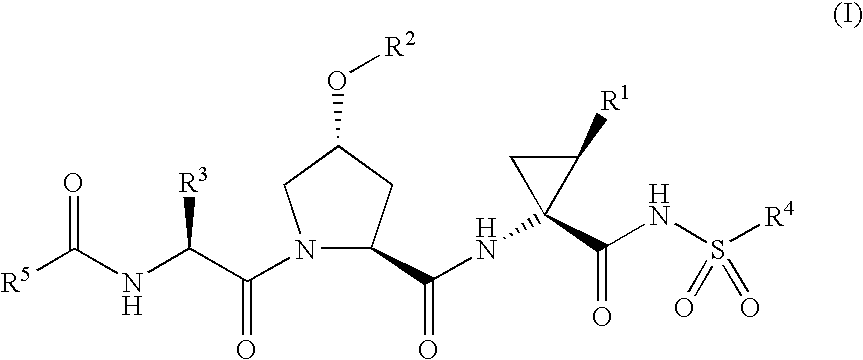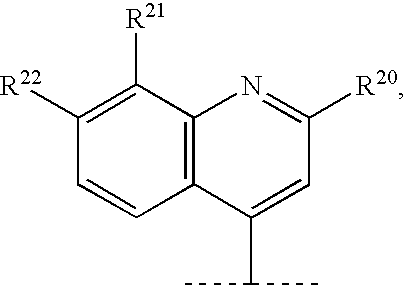Hepatitis C Inhibitor Peptide Analogs
a technology of hepatitis c virus and analogs, which is applied in the field of compound compositions and methods for the treatment of hcv infection, can solve the problems of lack of effective treatment, lack of cellular and humoral immune responses in protection against hcv infection and disease, and the recommendation of immunoglobulin treatment, etc., and achieves the effect of not showing significant inhibitory activity
- Summary
- Abstract
- Description
- Claims
- Application Information
AI Technical Summary
Benefits of technology
Problems solved by technology
Method used
Image
Examples
example 1a
Synthesis of P3 carbamate fragment 1A1
[0186]
[0187]The P3 carbamate fragment 1A1 was prepared as described in WO 03 / 064416 and WO 03 / 064456.
[0188]It will be apparent to one skilled in the art that analogous P3 carbamate fragments in which the cyclopentyl group has been replaced by another R50 substituent as defined herein and / or the tert-butyl group has been replaced by another R3 substituent as defined herein may be prepared using an analogous procedure.
example 1b
Synthesis of P3 urea fragment 1B1
[0189]
[0190]The preparation of P3 urea fragment 1B1 is described in WO 03 / 064456. Such fragments may be readily substituted for the P3 carbamate fragments in the examples below, to provide compounds of formula (I) wherein R5 is R50—NH— and R60 is cyclopentyl.
[0191]It will be apparent to one skilled in the art that analogous P3 urea fragments in which the cyclopentyl group has been replaced by another R50 substituent as defined herein and / or the tert-butyl group has been replaced by another R3 substituent as defined herein may be prepared using an analogous procedure.
example 2a
Synthesis of 1-methyl-2-methoxy aniline (2A2)
[0192]
[0193]To a solution of 2-methyl-3-nitro anisole (2A1) (5.1 g; 30.33 mmol; requires ˜30 min. to dissolve) in absolute ethanol (85 mL) was added 10% Pd / C catalyst (500 mg). The solution was hydrogenated under a hydrogen filled balloon at atmospheric pressure and room temperature for 19 h. The reaction mixture was filtered through a Celite pad, rinsed and evaporated to dryness to obtain the compound 2A2 as a deep mauve oil (4.1 g; 29.81 mmol; 98% yield).
[0194]MS 137 (MH)+. Reverse Phase HPLC Homogeneity @ 220 nm (0.06% TFA; CH3CN:H2O): 99%.
PUM
| Property | Measurement | Unit |
|---|---|---|
| temperature | aaaaa | aaaaa |
| temperature | aaaaa | aaaaa |
| weight | aaaaa | aaaaa |
Abstract
Description
Claims
Application Information
 Login to View More
Login to View More - R&D
- Intellectual Property
- Life Sciences
- Materials
- Tech Scout
- Unparalleled Data Quality
- Higher Quality Content
- 60% Fewer Hallucinations
Browse by: Latest US Patents, China's latest patents, Technical Efficacy Thesaurus, Application Domain, Technology Topic, Popular Technical Reports.
© 2025 PatSnap. All rights reserved.Legal|Privacy policy|Modern Slavery Act Transparency Statement|Sitemap|About US| Contact US: help@patsnap.com



